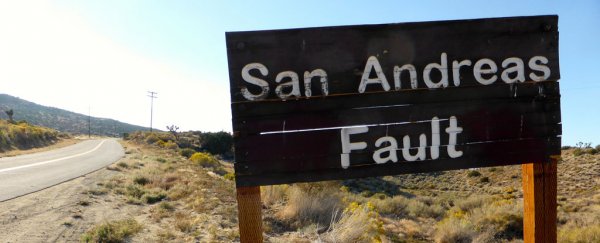Researchers have forecast a mega-quake running the entirety of the San Andreas fault line in California, and it looks like the effects for those living in the state could be far worse than previously realised.
Scientists used to think that the 1,300-km (800-mile) San Andreas fault line wasn't capable of rupturing all at once, but revised modelling by the US Geological Survey (USGS) last year showed that wasn't the case.
And now, scientists have extrapolated from that data to see just what the 'big one' would really mean for people living in California. The short version: it's not pretty.
According to the new analysis from researchers at US-based real estate intelligence firm CoreLogic, a single massive earthquake of magnitude 8.3 running the length of the San Andreas fault line could result in damage to a stunning 3.5 million homes throughout Northern and Southern California.
The damage bill for this epic quake? A whopping US$289 billion in estimated reconstruction costs.
By contrast, a weaker quake of magnitude 8.2 would damage 2.5 million homes and cost $183 billion, while an 8.0 quake would affect 2 million homes, costing $145 billion, the firm estimates.
Before we get any further, it's worth pointing out that the CoreLogic study hasn't been peer-reviewed by other scientists, so we need to bear that in mind when we consider its findings.
It's also worth considering that the company produced the research for its clients – including insurers that could benefit from an increase in home owners taking out earthquake-related insurance policies.
But scientists not involved in the research say it's not out of the question for something this big to occur.
"Scientists weren't really sure if you could have a rupture through the creeping section of the San Andreas," USGS research geophysicist Morgan Page, who took part in the 2015 research, told Jim Carlton at The Wall Street Journal.
"Now we think it's not very probable, but it is possible."
But we should be aware that these worst-case scenario quakes aren't your garden variety tremors. They're actually incredibly rare, with researchers putting the chances of a California-wide quake above magnitude 8.0 at about once every 2,500 years.
"We are talking about very rare earthquakes here," CoreLogic seismologist Maiclaire Bolton told The Wall Street Journal.
Prior to the 2015 modelling by the USGS, it was thought that the San Andreas fault could only rupture in isolated sections that were mutually exclusive.
If that were the case, an 8.3 quake in Northern California could only strike roughly 1.6 million homes. A separate 8.3 quake could damage 2.3 million homes in the south of the state – but both quakes couldn't happen at the same time.
Under the new USGS model – called Uniform California Earthquake Rupture Forecast, Version 3 (UCERF3) – the whole of San Andreas could hypothetically rupture at the same time, meaning the 'big one' would be even bigger than seismologists once realised.
The "creeping section" of the San Andreas fault that Page refers to above is a 153-km (95-mile) stretch that bridges the northern and southern segments of the fault.
"This is a fault between the tiny town of San Juan Bautista at the northwest end and Parkfield at the southern end that is continually moving," USGS science risk advisor Ken Hudnut told Kevin Smith at The Mercury News.
"It's moving and releasing energy instead of getting locked up. The rocks are of a different type there and there is enough fluid so they get ground down with a lot of slippage."
Under the UCERF3 modelling, seismic activity in this creeping section could help trigger a much larger earthquake, enabling a major quake originating on either side to span the north-south divide.
While it might be incredibly unlikely, the scientists say it's important to be aware of the possibility – no matter how slim.
"We've come to realise that we're not dealing with separate, isolated faults," USGS researcher Ned Field told Becky Oskin at Live Science in 2015 when the new model was released.
"We're dealing with an interconnected fault system… People should live every day like it could be the day of the big one."
The CoreLogic analysis is available on the company's website.
